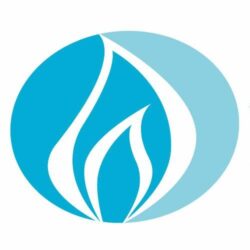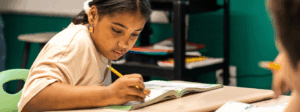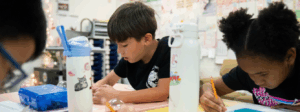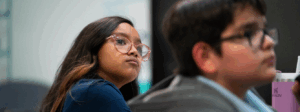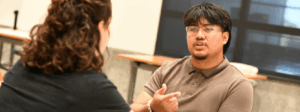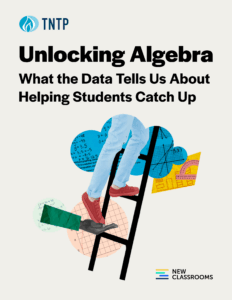The post below is an excerpt from our Learning Acceleration Guide, which we wrote to help districts and educators prepare for and address to learning loss due to COVID-19 school closures. Visit our Tools page to see more resources. If you have questions or are interested in learning more, please contact us.
***
Many students will need to fit even more than a year of learning into a single school year to make up for the learning they’ve lost. We recommend identifying the content knowledge and skills your students might struggle with in their current grade level, and filling those potential gaps “just in time,” when the material occurs in the school year.
This may feel like a radically different approach for some of your teachers and leaders. And in many ways, it is. Schools typically address gaps in content knowledge or proficiency by engaging in some form of remediation (or reteaching) around skills from previous years. While well intentioned, this approach often means that students who fell behind never encounter the work of their grade, instead remaining trapped in a cycle of low-quality or below-grade-level work. Instead of sending students backwards to fill in all the potential gaps in their learning, leaders and teachers should focus on filling in only the most critical gaps—and not in isolation, but at the moment they’re needed.
Addressing unfinished learning starts with two steps:
- Understanding the demands of grade-level materials and content. To begin this process, study the standards alongside year-long scopes and sequences to understand what standards and topics will be covered when, how students will apply their knowledge of the standards, and how they will show that knowledge. This means looking closely at the standards, the topics, and the tasks within a unit and across the year.
- Identifying the most critical prerequisite skills and content knowledge students will need to access that grade level content when they encounter it throughout the year.
For example, a ninth-grade English Language Arts teacher might look across the year and note that students will be reading Lorraine Hansberry’s A Raisin in the Sun in the fall. The teacher could give students an easier text to read and remove this book from the year-long sequence, out of fear that students are too far behind to tackle such a complex text at the beginning of the year.
Instead of removing the text and opting for something of lesser value, the teacher could note that tackling this text requires ready-made scaffolds for building students’ content knowledge about the topics and time period covered in Raisin. Additionally, because Hansberry obscures concepts like the Great Migration and redlining in rich figurative language, the teacher might identify understanding the purpose and meaning of figurative language as a critical prerequisite skill for tackling this complex text. Here we are thinking about the prerequisite knowledge that students need by considering the techniques the author uses to convey key ideas, along with the intentional topical knowledge that the curriculum seeks to build.
While engaging in complex texts is crucial, it is not the only component of strong literacy instruction. Foundational skills instruction (K-2) and writing are also key elements. As always, we want to make sure students are writing about what they are reading. We’ll tackle an approach to foundational skills in the section below, as it requires systematic assessments of student proficiency.
Now let’s imagine that you’re a math teacher or someone who supports mathematics in a system. The natural inclination here might be to make room for reteaching last year’s missed units by wholly eliminating any on-grade level units focused on “additional standards” and then, once the “reteach” portion of the year is complete, turning your attention to units focused on the “major work of the grade. But we know this approach did not lead to student growth in New Orleans after Hurricane Katrina.
Instead, you should identify the most important skills and concepts of each unit of study or standard. For example, if you’re a seventh-grade teacher who knows your sixth-graders missed their Statistics and Probability Unit, look to the seventh-grade Statistics and Probability Unit as a mechanism for recovering missed learning. You’d see that the most important sixth-grade skill for students to recover is their understanding of “measures of center such as mean” because, in seventh grade, students “use measures of center to draw inferences about a random sample.” Therefore, doing a multi-week sixth-grade Statistics Unit isn’t necessary. The teacher (and students) may only need one or two lessons on this sixth-grade concept to be ready to tackle the work of their grade.
We’ve just highlighted an example from seventh grade that covers an “additional standard” to show how those units can still be done, but even “major work of the grade” requires this thoughtful planning. For example, third-grade students might have missed their unit on fractions because these concepts often come at the end of the year. Understanding fractions is “major work” and a critical concept for students, but repeating the entire third-grade unit isn’t necessary. Teachers could focus more narrowly on the third-grade fraction concepts related to understanding 4 Hill, P. learning-losses. 9 equivalence of fractions (3.NF.A.3) because that is really what is carried forward in fourth grade. Again, a fourth grade teacher could ground a unit in one to two lessons on understanding fractions as a quantity and understanding equivalence with common denominators or common numerators (third grade content) before moving to the major work of fourth grade.
Identifying prerequisite skills can begin now and continue throughout the summer. This kind of work is best done collaboratively, ensuring that your curriculum and instruction team works with your district-level teams who focus on serving English Language Learners and students with IEPs. This can reduce potential blind spots by highlighting unique needs of special populations.
For example, multi-lingual learners or students receiving special education services may need an additional layer of support. Teams should reserve dedicated time to think through additional prerequisite content knowledge or skills for these populations as well. In addition to working collaboratively, there are tools that can help teachers with this process. In math for example, tools like standards’ focus by grade level guidance and the coherence map can help educators better understand the connection between standards and concepts.

